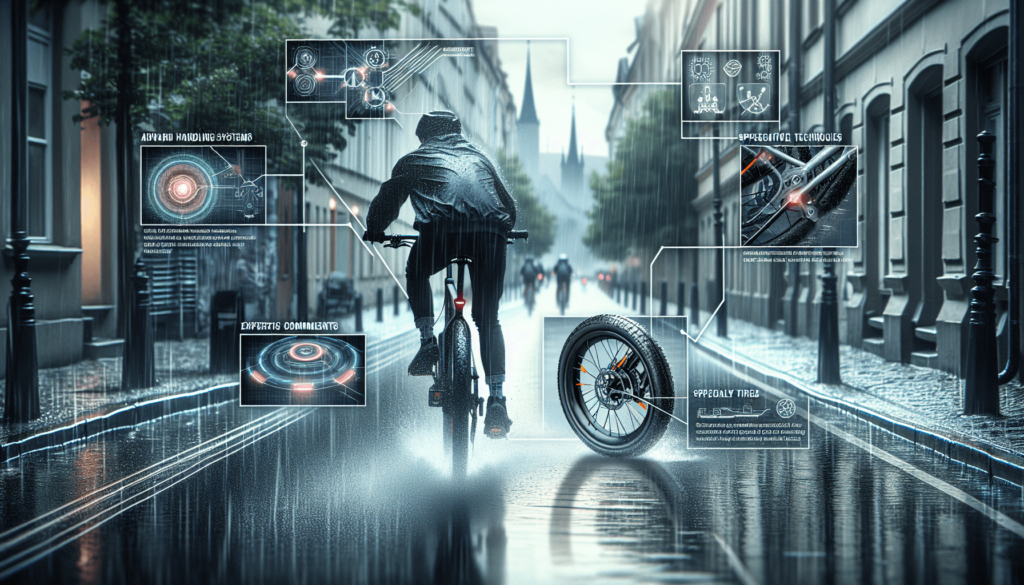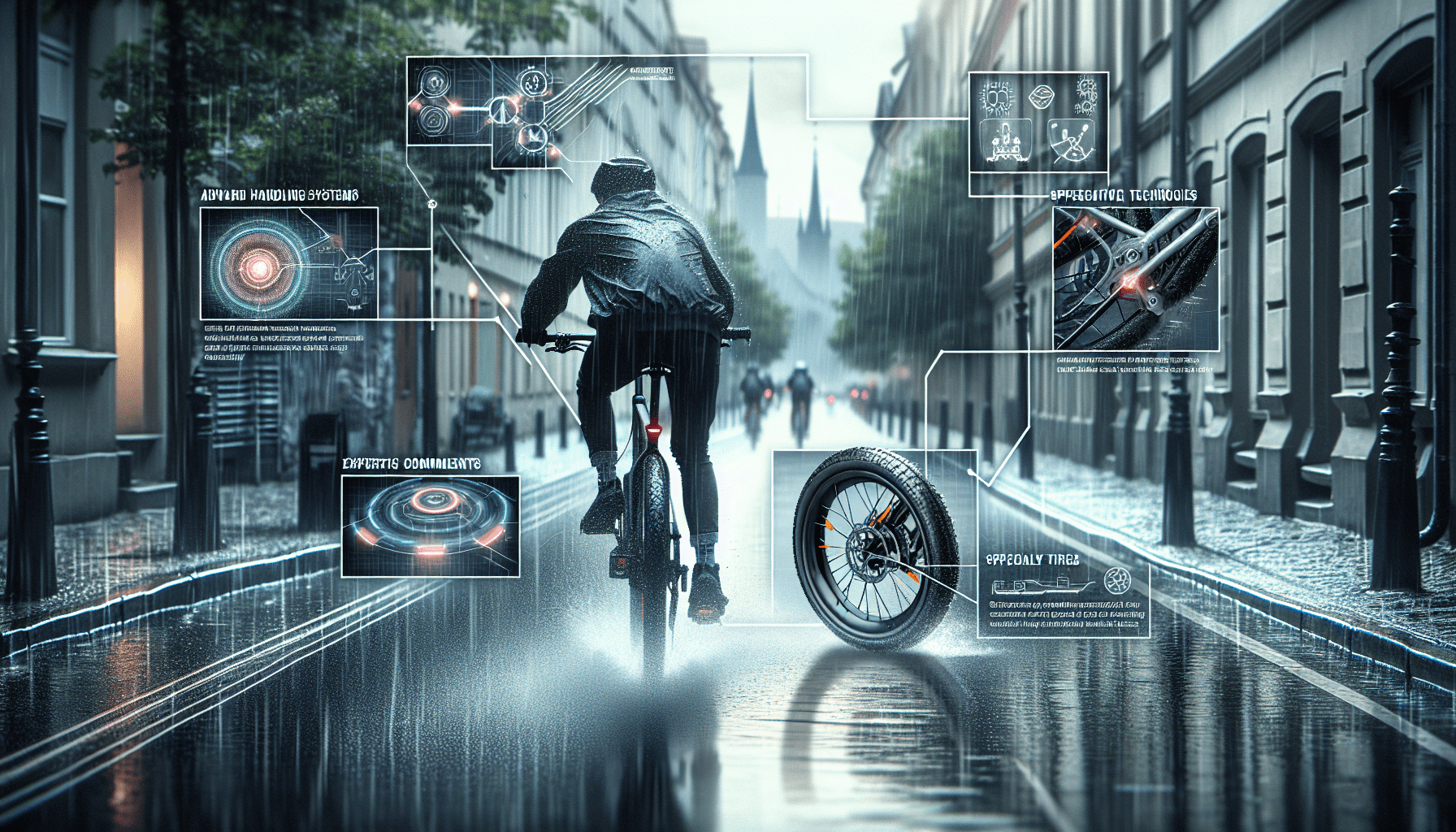Imagine gliding effortlessly through the streets on your e-bike, wind in your hair and a smile on your face. But what happens when those streets become coated in a slick sheen of rain or snow? How do e-bikes, with their electric assistance and unique design, handle on slippery surfaces? In this article, we will explore the fascinating world of e-bike traction and discover just how these innovative bikes navigate treacherous terrain with ease. So, strap on your helmet and prepare to be amazed by the incredible capabilities of e-bikes on slippery surfaces!
Overview of E-bikes on Slippery Surfaces
E-bikes, or electric bikes, have gained popularity in recent years due to their convenience and eco-friendly nature. However, one concern that e-bike riders often have is how they perform on slippery surfaces. In this article, we will explore the various factors that affect e-bike performance on slippery surfaces and discuss techniques and tips to improve their handling in such conditions.
Factors Affecting E-bike Performance on Slippery Surfaces
When it comes to riding an e-bike on slippery surfaces, several factors come into play that can significantly impact its performance. The three main factors we will be discussing are tire tread design, weight distribution and center of gravity, and the role of suspension systems. By understanding these factors, you can better grasp how to maneuver your e-bike safely on slippery surfaces.
Tire Tread Design and Its Impact
Tire tread design plays a crucial role in providing optimum traction on different surfaces, including slippery ones. Different tire tread patterns are designed to excel in specific conditions, such as wet roads, snow, or mud. In general, deeper and more aggressive treads are recommended for slippery surfaces to enhance grip. The tread pattern helps in channeling water or debris away from the contact patch, allowing the tire to maintain better traction.
Weight Distribution and Center of Gravity
The way weight is distributed on your e-bike and its center of gravity can have a notable impact on its performance on slippery surfaces. Ideally, you want to have an evenly distributed weight between the front and rear wheels, which helps maintain better balance and control. Additionally, lowering the center of gravity by keeping heavier components, such as the battery, lower on the frame enhances stability and maneuverability. This becomes particularly important when you encounter slippery surfaces that require quick and precise handling.
Suspension Systems and Their Role
Suspension systems in e-bikes are designed to absorb bumps and shocks, providing a smoother and more comfortable ride. When it comes to slippery surfaces, a suspension system becomes even more critical. It helps in maintaining better traction by keeping the wheels in contact with the ground, especially when the terrain is uneven or slippery. There are different types of suspension systems available, including front suspension forks and full suspension. These systems play a vital role in improving the e-bike’s performance on slippery surfaces.
Understanding E-bike Handling
E-bikes have unique handling characteristics that differ from traditional bicycles. It is important to understand these differences and how they affect the e-bike’s performance on slippery surfaces.
Handling Characteristics of E-bikes
E-bikes tend to have a slightly different feel when it comes to handling compared to their traditional counterparts. This is primarily due to the added weight of the electric motor and battery, which can affect maneuverability. Additionally, the instant torque provided by the electric motor can change the way the bike responds to acceleration. Understanding how these handling characteristics differ from a regular bicycle will help you adjust your riding technique when encountering slippery surfaces.
Comparison with Traditional Bicycles
When it comes to riding on slippery surfaces, e-bikes offer some advantages over traditional bicycles. The electric motor assistance can help provide additional power and traction, making it easier to navigate through slippery or steep terrain. This can be particularly beneficial when riding uphill or encountering challenging surfaces. However, it is important to remember that e-bikes still require appropriate handling techniques and precautions, as they are not completely immune to the challenges posed by slippery surfaces.
Effects of Electric Motor Assistance
The electric motor assists in propelling the e-bike forward, making it easier to tackle various terrains. When riding on slippery surfaces, the electric motor can help maintain momentum and power, reducing the likelihood of getting stuck. However, it is essential to use the electric motor assistance judiciously, as excessive throttle or sudden bursts of power can cause the wheels to lose traction and result in loss of control. It is important to find the right balance and use the electric motor assistance in a controlled manner when handling slippery surfaces.
Tire Tread and Its Importance
Tire tread is a crucial factor that determines the e-bike’s ability to grip the road or surface. When it comes to riding on slippery surfaces, the right tire tread pattern can make all the difference in maintaining control and avoiding accidents.
Different Types of Tire Tread Patterns
There are various tire tread patterns available in the market, each designed for specific conditions and terrain. Some common tread patterns include slick or smooth tread, knobby tread, and all-purpose tread. Slick or smooth tread patterns are suitable for riding on paved surfaces, such as roads or sidewalks. Knobby tread patterns, with their larger and more pronounced knobs, are ideal for off-road or loose surfaces. All-purpose tread patterns provide a balance between grip on paved surfaces and off-road capabilities. When selecting a tire tread pattern for slippery surfaces, it is important to opt for deeper and more aggressive treads that can dig into the ground and provide better traction.

Influence of Tread on Traction
The tread pattern on your e-bike tires plays a crucial role in determining the amount of traction they can provide on slippery surfaces. Deeper treads with wider spacing between knobs are better at channeling away water, mud, or snow, ensuring the tires maintain better contact with the ground. The tread design helps in preventing hydroplaning and increases the gripping ability of the tire, reducing the risk of slipping or sliding on slippery surfaces.
Selecting the Right Tire Tread for Slippery Surfaces
When it comes to slippery surfaces, it is crucial to choose the right tire tread pattern for your e-bike. Look for tires with deep, aggressive treads that can bite into the surface and provide excellent traction. Consider opting for specialized tires designed specifically for slippery conditions, as they often have unique features that enhance grip. Also, make sure to check the manufacturer’s recommendations and consider consulting experienced riders or professionals to find the most suitable tire tread pattern for your e-bike.
Weight Distribution and Center of Gravity
Proper weight distribution and center of gravity greatly influence the e-bike’s grip and stability on slippery surfaces. Understanding how weight distribution and center of gravity impact your e-bike’s performance will help you navigate through slippery conditions with confidence.
How Weight Distribution Affects Grip
The distribution of weight between the front and rear wheels significantly affects the e-bike’s grip on the road or surface. An even distribution of weight allows the tires to maintain better contact with the ground, enhancing traction. If the weight is too heavily concentrated on one wheel, it can cause loss of traction, making it more challenging to control the e-bike on slippery surfaces. It is crucial to ensure that the weight is balanced between the front and rear wheels for optimum grip and control.
Importance of Lowering the Center of Gravity
Lowering the center of gravity is another key element in enhancing the e-bike’s performance on slippery surfaces. When the center of gravity is lower, it increases stability and reduces the likelihood of the e-bike tipping over. This is particularly important when riding on slippery surfaces, as it allows for better maneuverability and control. To lower the center of gravity, consider keeping heavier components, such as the battery, as low as possible on the e-bike’s frame. This simple adjustment can vastly improve your ability to navigate through slippery conditions with ease.
Impact on Stability and Maneuverability
Proper weight distribution and a lowered center of gravity contribute to improved stability and maneuverability on slippery surfaces. With proper weight distribution, the e-bike can handle turns and corners with better precision, reducing the risk of sliding out. Additionally, a lowered center of gravity provides a more stable platform, allowing for better control and confidence when riding on slippery surfaces. It is essential to practice riding techniques that leverage these advantages to maximize your e-bike’s performance on slippery surfaces.
Suspension Systems and Their Role
Suspension systems are a vital component of e-bikes, especially when it comes to riding on slippery surfaces. Let’s explore the different types of suspension systems and their impact on performance.
Types of Suspension Systems in E-bikes
There are primarily two types of suspension systems found in e-bikes: front suspension forks and full suspension. Front suspension forks, as the name suggests, provide suspension only for the front wheel, while full suspension systems offer suspension for both the front and rear wheels. The suspension helps absorb shocks and impacts from uneven terrain, ensuring the wheels maintain good contact with the ground.
Benefits of Suspension Systems on Slippery Surfaces
Suspension systems on e-bikes play a significant role in improving performance on slippery surfaces. The suspension helps maintain better traction by keeping the wheels in contact with the ground, even on uneven or bumpy surfaces. This is particularly beneficial when riding on slippery surfaces, as it reduces the chances of losing control due to sudden bumps or shocks. The suspension absorbs the impact, allowing the tires to maintain better grip and providing a smoother ride.
Recommendations for Appropriate Suspension Systems
When it comes to selecting the right suspension system for riding on slippery surfaces, it is important to consider the type of terrain you typically encounter. If you primarily ride on paved surfaces or encounter occasional slippery conditions, a front suspension fork may suffice. However, if you frequently ride on off-road or challenging terrains, a full suspension system will provide better overall performance and control. Consider your riding style and preferences, and consult with experts or experienced riders to determine the most appropriate suspension system for your e-bike.
Techniques for Riding E-bikes on Slippery Surfaces
When faced with slippery surfaces, employing the right techniques can greatly improve your e-bike’s performance and safety. Here are some important techniques to remember when riding on slippery surfaces.

Reducing Speed and Braking Techniques
The first and most crucial technique when riding on slippery surfaces is to reduce your speed. Slower speeds give you more time to react and make adjustments, reducing the risk of losing traction. When braking, apply the brakes gradually and avoid sudden or harsh braking, as it can cause the wheels to lock up or skid. Use both the front and rear brakes together in a controlled manner, distributing the braking force evenly. This helps maintain better stability and control while reducing the chances of sliding or skidding on slippery surfaces.
Applying Steady and Smooth Pedaling
When pedaling on slippery surfaces, it is important to maintain a steady and smooth pedaling technique. Avoid sudden bursts of power, as it can cause the wheels to lose traction and result in a loss of control. Instead, apply consistent and measured pedal strokes to maintain a steady pace. Focus on maintaining a balanced and controlled riding style, distributing your weight evenly and avoiding any sudden movements that may upset the bike’s stability.
Keeping a Safe Distance and Maintaining Balance
Maintaining a safe distance from other vehicles or riders and ensuring you have enough stopping distance is essential when riding on slippery surfaces. The increased distance allows for more reaction time and ensures you can avoid sudden obstacles or hazards. Additionally, it is crucial to maintain your balance and body position on the e-bike. Keep your weight centered and distribute it evenly between the front and rear wheels to ensure maximum traction and stability. Be mindful of your body’s movements and avoid any sudden shifts that could disrupt the e-bike’s balance.
Tips to Improve E-bike Performance on Slippery Surfaces
In addition to proper techniques, there are specific tips that can further enhance your e-bike’s performance on slippery surfaces.
Preparation and Inspection of the E-bike
Before heading out on slippery surfaces, it is important to thoroughly inspect your e-bike and ensure it is in good working condition. Check for any loose or worn-out components, tighten bolts if necessary, and make sure the brakes are functioning properly. Additionally, consider performing regular maintenance tasks, such as cleaning and lubricating the chain, to ensure optimal performance. A well-maintained e-bike is more likely to handle slippery conditions with greater ease.
Choosing the Right Tire Pressure
Tire pressure plays a crucial role in the e-bike’s performance on slippery surfaces. It is important to find the right balance when it comes to tire pressure, as both overinflated and underinflated tires can negatively impact traction. Overinflated tires tend to have less grip, especially on slippery surfaces, while underinflated tires can increase rolling resistance and make pedaling more challenging. Refer to the manufacturer’s recommendations or consult experienced riders to find the optimal tire pressure for your e-bike on slippery surfaces.
Enhancing Traction with Tire Chains or Studs
In particularly icy or treacherous conditions, enhancing traction with tire chains or studs can drastically improve your e-bike’s performance. Tire chains provide added grip by forming a physical connection between the tires and the road. Studs, on the other hand, are small metal spikes embedded in the tire tread, enhancing traction on icy or compacted surfaces. Consider adding tire chains or studs to your tires if you frequently encounter slippery surfaces with challenging conditions.
Safety Measures for Riding on Slippery Surfaces
Riding on slippery surfaces always poses additional risks, so it is crucial to prioritize safety. Here are some important safety measures to keep in mind when riding your e-bike on slippery surfaces.
Wearing Protective Gear
Protective gear is a must when it comes to riding any type of bicycle, and e-bikes are no exception. When riding on slippery surfaces, the risks of falling or losing control increase. It is important to wear a properly fitted helmet, as well as other protective gear, such as knee and elbow pads, to minimize the risk of injuries. Additionally, consider wearing clothing that provides visibility to other road users, such as reflective or brightly colored garments.
Using Lights and Reflectors
Visibility is crucial when riding on slippery surfaces, especially in low-light conditions or during adverse weather. Ensure that your e-bike is equipped with functioning lights and reflectors. Use headlights to illuminate the road ahead, tail lights to make your presence known to vehicles behind you, and reflective materials to increase your visibility from different angles. Being visible to other road users greatly reduces the risk of accidents or collisions in slippery conditions.
Awareness of Surroundings and Hazards
Maintaining situational awareness is key when riding on slippery surfaces. Keep an eye out for potential hazards, such as potholes, loose gravel, or wet patches. Adjust your speed accordingly and give yourself enough space and time to react. Anticipating and identifying potential risks and hazards helps you make better decisions and allows for safer maneuvering on slippery surfaces.
Maintenance and Care for E-bikes in Slippery Conditions
Riding on slippery surfaces can result in increased wear and tear on your e-bike. Regular maintenance and care are crucial for keeping your e-bike in optimal condition and ensuring its performance remains top-notch.
Cleaning and Lubricating the Chain
The chain is one of the most critical components of an e-bike, and it is important to keep it clean and properly lubricated. After riding on slippery surfaces, there may be a buildup of dirt, mud, or grime on the chain. Clean it thoroughly using a suitable degreaser and a brush, and then apply lubricant to reduce friction and ensure smooth operation. Regular chain maintenance helps prolong its lifespan and ensures your e-bike’s performance is not compromised by a dirty or dry chain.
Inspecting Brake Pads and Discs
Brake pads and discs are of utmost importance, especially when riding on slippery surfaces that may require sudden or frequent braking. Check the brake pads for wear and tear, ensuring they have sufficient thickness. If the brake pads are worn or damaged, replace them immediately to maintain optimal braking performance. Additionally, inspect the brake discs for any signs of warping or damage, as this can affect the efficiency of the brakes. Keep the brake system clean and free from any debris, as a clean brake system ensures better braking power and control.
Regular Maintenance and Check-Ups
Regular maintenance and periodic check-ups by a professional can go a long way in ensuring your e-bike is in top shape and ready to handle slippery conditions. Schedule routine maintenance sessions to have your e-bike inspected, adjusted, and properly serviced. The professional expertise will help identify any potential issues or areas of concern that may affect your e-bike’s performance. Regular maintenance and check-ups contribute to a safer and more enjoyable riding experience, even on slippery surfaces.
Conclusion
Riding an e-bike on slippery surfaces can be a challenging but manageable task with the right understanding and techniques. By considering factors such as tire tread design, weight distribution and center of gravity, suspension systems, and appropriate handling techniques, you can confidently navigate through slippery conditions. Additionally, following the tips and safety measures outlined in this article, along with proper maintenance and care, will ensure your e-bike performs optimally in slippery conditions. So, next time it rains or the road gets icy, you can confidently hop on your e-bike and enjoy a safe and exhilarating ride.

